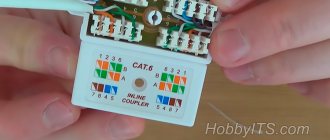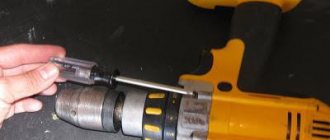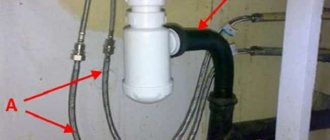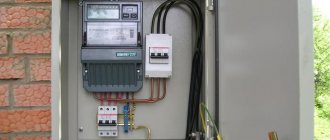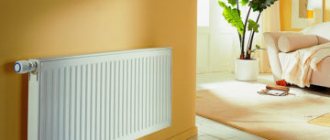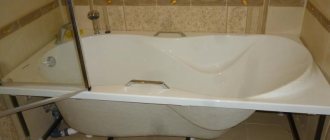The ban on the use of aluminum wiring in residential premises was introduced more than fifteen years ago for fire safety reasons, but with the advent of new aluminum alloys, which are not inferior in characteristics to copper cables, the situation has changed radically.
The area of use of the wire depends not only on the type of conductor, but also on the insulation material, as well as the design features of the product. Today, aluminum cables provide transmission and distribution of electricity in various stationary installations. In residential buildings, cables with an aluminum conductor cross-section of 16 mm 2 or more are laid.
The undeniable advantages of aluminum cables are affordability, low weight and the formation of a persistent oxide film, while the disadvantages include fragility, low electrical conductivity, a tendency to oxidize and a relatively short service life.
Twist
Aluminum wires are often connected to each other using twisting. This is the simplest, but also the most dangerous method of connecting wires to each other.
The sequence of actions when using this technology will be as follows:
- First , remove the insulation from the wires approximately 4-5 cm on each side. It is most convenient to use a special tool designed specifically for this purpose.
- Now the contacts should be degreased. To do this, you will have to wipe them with a cloth pre-moistened in acetone.
- Sandpaper is used to remove the oxide film from the surface of the metal, that is, to clean it until a metallic shine is obtained.
- The wires are crossed with each other , after which one of the wires is wound as tightly as possible onto the other using pliers.
- The second wire is wound onto the first in the same way.
- The twist should now be insulated using insulating tape. Professional electricians also recommend using a special heat-shrinkable tube or cambric. With its help, you can qualitatively protect the exposed area from the negative effects of the external environment.
In principle, the technology is quite simple. You just need to remember that the wires need to be exposed at least 4-5 cm, and the twisting should not be done manually, but only with the help of pliers, so that the wires fit as closely as possible to each other.
If this is not done, the result will be loose contact, which can cause the area to become very hot. In turn, this effect causes a short circuit, and in some cases even a fire.
Useful tips
To make the contact of the wires as reliable as possible, experts advise:
- periodically tighten the screw connection so that the contact does not weaken over time;
- if it is not possible to use another method other than twisting, it is recommended to additionally use PPE caps;
- to get better soldering, it is better to use pure mineral oil (gun or sewing machine oil) instead of rosin;
- When choosing self-clamping terminals, check them for compliance with the cross-sectional area of the connected cables and their number.
Using any of the methods described, you can reliably and firmly connect aluminum wires. The choice of technology depends on the situation, operating conditions of the wiring and the availability of the required tools and parts from the technician.
Safety precautions
- When connecting wires , you must be careful and strictly follow the operating instructions, which prohibit simple twisting (twisting in a spiral) of wire made of aluminum and any other metal (copper, aluminum-copper, aluminum). The reason is that when aluminum oxidizes, it releases galvanic vapor, which will sooner or later break the contact, and sparks that occur when high-power currents pass through such contacts often cause a fire.
- Aluminum welding is the most traumatic - to avoid trouble, be sure to use rubber boots and a welding helmet.
- in the room where welding is carried out to prevent fire.
- Even wooden floors are recommended to be covered with iron sheets.
Terminal block
This method has one significant disadvantage. Most of the pads sold are of very poor quality.
Some people get clever and, in order to avoid direct contact between copper and aluminum, the copper core is soldered to the side of such a clamp, rather than inserted inside.
True, the terminal will have to be disassembled for this. In addition, reliable aluminum contact under the screw without revision does not last very long.
The screws will need to be tightened every six months to a year. The frequency of revision work will directly depend on the load and its fluctuations during periods of maximum and minimum.
Forget to tighten up and expect trouble. And if this entire connection is hidden deep in the socket, then getting into it every time is not a very convenient task.
Therefore, the most reliable method available is crimping. Here we will not consider the use of specialized copper-aluminum sleeves GAM, since they start from sections of 16mm2.
For home wiring, as a rule, you need to increase the wires by 1.5-2.5 mm2 no more.
Safety regulations
When performing all electrical work, in order to protect themselves and others, they comply with safety regulations and strictly follow the developed instructions:
- simple twisting of aluminum conductors with copper or copper-aluminum conductors is not allowed, because during the electrolysis process, the contact is destroyed, overheats, and sparks;
- when welding, be sure to use a protective mask and rubber boots;
- in the room where welding work is performed, flammable objects are reliably protected;
- It is better to lay aluminum wiring, especially if it is open, in corrugated sleeves, and place the connections in junction boxes;
- welding and soldering are performed only by people with the appropriate skills;
- All exposed parts of the wires are reliably insulated.
Piercing clamps
An improved model of nut cable compression are piercing clamps. Disposable products, however, allow you to make a wire branch without cutting and even without peeling off the insulating layer when splicing. The design of the clamp is represented by a hexagonal head, which tightens the conductors, as well as contact plates with teeth, which actually pierce the insulating material.
They are most often used to branch from an overhead line laid with SIP wire without relieving the voltage.
The advantage of these products is as follows:
- You can branch wires from an overhead line (OHL) even under voltage, without fear for your safety. This is due to the fact that the contact plate is reliably insulated from the clamping bolts.
- The housing of the products is sealed and reliably protects the connection point from bad weather conditions.
- The clamps are easy to use and have a long service life.
- Low cost of production.
- Possibility of bonding copper and aluminum conductors.
As for the disadvantages, the main thing is only the “disposability” of the product, but this point is very controversial, given the durability of this method of branching wires without breaking.
Installation is carried out as follows:
Video instructions for installing a piercing clamp
Methods for connecting aluminum wires
As we said above, aluminum wires can be connected in four main ways - screw or bolt clamps, pressing, welding and soldering. Let's look at the features of each of these types of connections.
Connecting aluminum wires using the compression method
Let's start with the most common connection method - compression. It can be of several types - bolted, screw or using a pressure spring, which is used in Wago terminals.
The screw terminal may damage the aluminum wire
Brass lugs for aluminum wires
Aluminum lugs for bolting wires and cables
Wago terminals for connecting aluminum wires
Connecting aluminum wires using the pressing method
Recently, connecting aluminum wires with a sleeve has become increasingly popular. This is partly due to the widespread use of crimpers or, as they are also called, crimping pliers. This tool allows you to crimp wires of different sections, ensuring fairly reliable contact.
Crimpers for crimping wires
Sleeves for connecting aluminum wires
- The connection of wires by crimping is carried out using special sleeves. These sleeves are available in different diameters and materials. To connect aluminum wires, either aluminum or brass sleeves should be used. Copper should not be used under any circumstances, since the connection of these two materials can lead to the formation of galvanic isolation and ultimately the complete destruction of the aluminum conductor.
Note! The cross-section of the sleeve for connecting wires must correspond to the cross-section of the wire. If you use a sleeve with a smaller cross-section, then to insert the wire into the sleeve you will have to reduce its cross-section, which will negatively affect the contact. If you use a sleeve with a larger cross-section than the wire, then the area of the contact connection will be much smaller, which again will lead to overheating of the contact.
Sleeves for connecting wires of different sections
- To connect wires of different sections, there are sleeves with different diameters of the inlet holes. They can also be used to connect more than two wires in one sleeve.
- Sleeves for connecting aluminum wires have a strictly required length. Believe me, the manufacturer did not make a reserve in the sleeve, so cutting the sleeve in half in order to save money is a very bad option. After all, when connecting two wires, crimping should be done twice with opposite crimps. If you cut the sleeve in half, you won't be able to do this, and the contact will be poor quality.
Required Tools
There are different methods for connecting wires, and each method will require different tools.
For mechanical connections
If a mechanical method is used, use:
- pliers;
- knife or device for cleaning wires from insulation;
- devices used to make the connection (terminals, clamps, PPE caps, etc.).
If you use the crimping method, you will need press jaws or a press (mechanical or hydraulic).
For welding
In this case you will need:
- burner;
- oscillator;
- protective equipment (mask, gloves, rubber boots);
- argon arc welding machine.
Electrochemical corrosion of joined metals
There is an opinion that it is unacceptable to connect aluminum and copper wires directly together and this is indeed a scientifically proven fact. Is it possible to connect a copper wire to a galvanized terminal? Of course, you cannot immediately give an answer, but in a minute you will be able to navigate this issue no worse than an experienced chemist.
What happens when two different current conductors come into contact? If there is no moisture, the connection will always be reliable. But there is always water vapor in the atmospheric air, which is the culprit for the destruction of contacts. Each current conductor has a certain electrochemical potential. This property of metals is widely used in technology, for example, thermocouples are made.
But if water gets between the metals, it forms a short-circuited galvanic cell, current begins to flow, and just as one of the electrodes is destroyed in the galvanic bath, so one of the metals in the connection is destroyed. The electrochemical potential of each conductive material is known, and knowing the value, you can accurately determine which materials can be connected to each other.
Table of electrochemical potentials (mV) arising between connected conductors
| Metal | Copper and its alloys | Lead-ol. solder | Aluminum | Duralumin | Steel | Stainless steel steel | Zinc coating | Chrome coating | Silver | Carbon (graphite) | Gold Platinum |
| Copper and its alloys | 0,00 | 0,25 | 0,65 | 0,35 | 0,45 | 0,10 | 0,85 | 0,20 | 0,25 | 0,35 | 0,40 |
| Lead-ol. solder | 0,25 | 0,00 | 0,40 | 0,10 | 0,20 | 0,15 | 0,60 | 0,05 | 0,50 | 0,60 | 0,65 |
| Aluminum | 0,65 | 0,40 | 0,00 | 0,30 | 0,20 | 0,55 | 0,20 | 0,45 | 0,90 | 1,00 | 1,05 |
| Duralumin | 0,35 | 0,10 | 0,30 | 0,00 | 0,10 | 0,25 | 0,50 | 0,15 | 0,60 | 0,70 | 0,75 |
| Soft steel | 0,45 | 0,20 | 0,20 | 0,10 | 0,00 | 0,35 | 0,40 | 0,25 | 0,70 | 0,80 | 0,85 |
| Stainless steel steel | 0,10 | 0,15 | 0,55 | 0,25 | 0,35 | 0,00 | 0,75 | 0,10 | 0,35 | 0,45 | 0,50 |
| Zinc coating | 0,85 | 0,60 | 0,20 | 0,50 | 0,40 | 0,75 | 0,00 | 0,65 | 1,10 | 1,20 | 1,25 |
| Chrome coating | 0,20 | 0,05 | 0,45 | 0,15 | 0,25 | 0,10 | 0,65 | 0,00 | 0,45 | 0,55 | 0,60 |
| Silver | 0,25 | 0,50 | 0,90 | 0,60 | 0,70 | 0,35 | 1,10 | 0,45 | 0,00 | 0,10 | 0,15 |
| Carbon (graphite) | 0,35 | 0,60 | 1,00 | 0,70 | 0,80 | 0,45 | 1,20 | 0,55 | 0,10 | 0,00 | 0,05 |
| Gold Platinum | 0,40 | 0,65 | 1,05 | 0,75 | 0,85 | 0,50 | 1,25 | 0,60 | 0,15 | 0,05 | 0,00 |
According to the requirements of the standard, mechanical connection between materials is allowed, the electrochemical potential (voltage) between them does not exceed 0.6 mV.
As can be seen from the table, the reliability of contact when connecting copper to stainless steel (potential 0.1 mV) will be much higher than with silver (0.25 mV) or gold (0.4 mV)!
And if a copper wire is coated with tin-lead solder, then you can safely connect it with aluminum in any mechanical way!
After all, then the electrochemical potential, as can be seen from the table, will be only 0.4 mV.
Spring
In this case, special terminal blocks are used. Due to the presence of a special spring, there is no need to regularly tighten the contact. The inserted stripped aluminum wire is held securely. There are terminal blocks, both disposable and reusable. Disposable ones are used to connect wires without further disconnection. The wire is inserted into the hole in the clamp; it cannot be pulled back out. As for the reusable connection, the wire is easily pulled out if you press the special lever that holds the wire.
Underground cable branch
The beginning and end of the underground branch must be laid in a metal protective tube extending from the ground to the support to a height of at least 1.8 meters. An underground branch cable is safer and more stable, but only if it runs through your property.
The cable is protected from mechanical damage at a height of 2.5 m from the ground and at a depth of 0.3 meters in depth. The portion between the start and end points of a branch may not be protected by a pipe.
is dug with a depth of at least 0.7 meters, preferably 0.8, a backfill of 10 centimeters of sand is made and a cable is laid with a reserve length. You can also pour 10 cm of sand and seeded soil without stones and foreign objects on top.
There should be no solid objects in The soil can be compacted; all you have to do is walk on it; over time it will settle a little, so you can make a small mound.
When crossing roads for cars, garage exits, branch cables are laid in pipes. Entry into the building is also carried out using pipes.
Mistake #6 – Skew
When installing the clamp, it must not be skewed relative to the cores.
Most often this happens when tightening by hand, when the puncture is not held by a special holder.
Most “piercings” have protrusions at the bottom where the holder is inserted.
Believe me, not everyone can hold the clamp straight in their hand.
Mistake #8 – Tightening with open-end wrenches
The shear nut must be tightened with spanners, not open-end wrenches.
Yes, of course, this can be done with carobs, but here the issue of skew again comes to the fore.
At the wrong moment, the key may break off and, due to the jerk, the puncture will become distorted, and the teeth, instead of deepening into the body of the insulation, will simply move to the side and become crushed.
The moment the bolt head comes off is not that small. On some clamps it is even indicated on the body (14 Nm - newton meter).
Which break head is better – metal or plastic?
Metal is still more reliable. This is explained by the smaller scatter of the stall moment.
This is especially true in winter, at subzero temperatures. The breaking torque of plastic will vary within a larger range from the factory parameters.
Accordingly, the contact will be of less quality.
Socket wrenches instead of open-end wrenches are also not always convenient. The breakaway nut often gets stuck inside the key.
The ideal option is spanners with a ratchet.
With them, the clamp does not twist the hand, and the applied force is transmitted perpendicular to the bolt, and not through an angle.
Some even rip off the head with a wrench.
But to do this, first of all you need to have such a tool at hand.
Mistake #10 – Repeated installation and dismantling
Dismantling the piercing clamp is possible, but reinstalling it is unacceptable!
The piercing elements (teeth) are very deformed and when reconnected they simply will not provide good contact.
By the way, regarding dismantling, although this is theoretically allowed, if you need to reconnect or replace the input, it is better not to touch the old puncture at all, but to place another one next to it.
By removing the clamp from the old place, you thereby break the tightness and expose the puncture sites.
Through them, moisture will penetrate into the SIP. For reliable insulation you will need a special sealed tape, which is not so easy to get.
Mistake #9 – Shear nut
Electricians who are faced with the installation of SIP for the first time and do not fully understand the principles of connecting wires through a puncture may generally leave the shear nut in place.
Yes, yes, this happens (they are afraid to break
